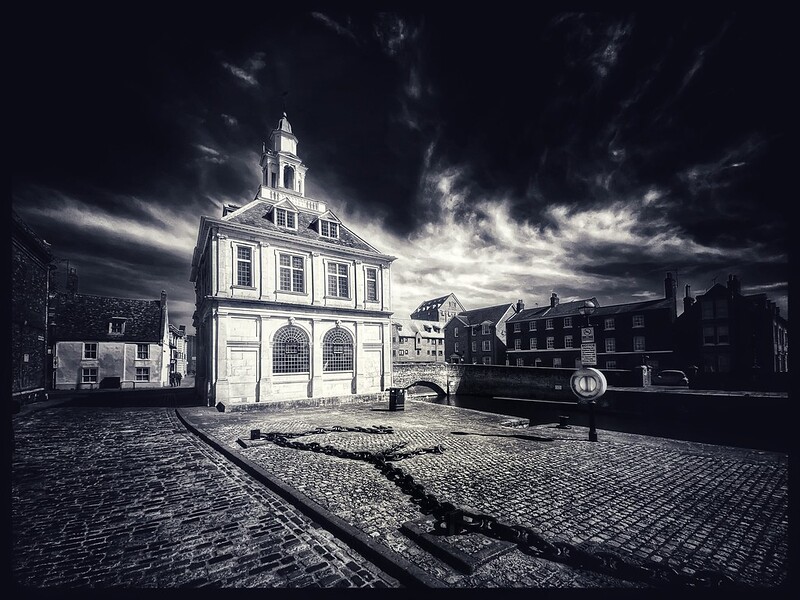The Original Purpose Wasn’t A Custom House
The Custom House in King’s Lynn is one of the town’s most iconic buildings. However, few people know that it was not built as a Custom House. It was originally a Merchant Exchange – a place for merchants to meet, inspect goods, and do deals.

Photo © James Rye 2021
The first floor of the merchants’ exchange was let to the Collector of Customs and it only became the official Custom House in 1703 (18 years after the building was originally opened), being sold to the Crown in 1717 for £800. The Custom House continued to be occupied by HM Customs and Excise until 1989 when it passed into private ownership.
It is rumoured that Robert Walpole himself was not averse to occasionally popping in on his journeys to and from London to sample some of the products being imported. After all, he was buying a lot of wine (orders of 1000 bottles at a time) for Houghton Hall. Walpole was to develop family links with Sir John Turner who paid for the building.
The needs of the local merchants had been previously met by a building called Hogge Mansion at 91 High Street where they gathered from 1620. However, this building proved to be too small, so they temporarily met in St George’s Guildhall until the Merchant Exchange was completed in 1685.
Custom House: The Most Perfect Building
The building was designed by a local architect, Henry Bell, who had been influenced by Robert Hooke who had worked with Christopher Wren when rebuilding St Paul’s Cathedral after the Fire of London in 1666. Bell copied the style of Dutch Merchant Exchanges (classical pilasters, petite dormer windows, balustrade and cupola) and produced what the architectural historian Nikolaus Pevsner described as ‘one of the most perfect buildings ever built’.
At the time the design of the exchange was very much more sophisticated than anything that had previously been built in King’s Lynn, and was the first building in Lynn to use the grammar of classical architecture correctly.

Photo © James Rye 2021
The building was constructed of stone and had four bays by five. The ground floor was originally open – you can see the filled in original arches. There is a tall wooden lantern above the first floor.
A statue of Charles II sits above the door (see Lynn MP’s Netflix Conversation). Figure-heads of Ceres, the Roman Goddess of Corn and of Bacchus the Roman god of wine also decorate the building. The exported corn paid for the imported wine.
John Turner: The Man With The Money
Sir John Turner, the local MP and three-time Mayor, had the building constructed next door to his house at 1 King Street, King’s Lynn. As he was also a local wine merchant, he didn’t have to travel far to sample his imports or secure his deals.
The Latin inscription above the door – “Mercaturae Reipublicae Nauticae Hoc Posuit Johannes Turner Anno Dom 1683”:- translates as “Johannes Turner, Esquire, placed this here for the Maritime Commerce of the Republic in the Year of the Lord 1683.”
Turner, son of a North Elmham lawyer, had been apprenticed to a Cambridge vintner. After marrying his master’s widow he moved to Lynn where two of his brothers were in practice as attorneys. His trade prospered, and he rapidly became a leading member of the corporation.
Turner also employed Bell to build the Duke’s Head on the Tuesday Market Place so that the merchants visiting the town would have a respectable place to stay.
Follow this up with the Netflix Conversation of the Lynn MP.
© James Rye 2022
Sources
Higgins, D. (2005) The Ingenious Mr Henry Bell: His Life, His Work, His Legacy: His King’s Lynn, Phoenix Publications
https://www.heritage.norfolk.gov.uk/record-details?MNF5479-Custom-House
https://www.britainexpress.com/counties/norfolk/properties/kings-lynn-custom-house.htm
https://www.historyofparliamentonline.org/volume/1660-1690/member/turner-john-1632-1712
https://www.historyofparliamentonline.org/volume/1690-1715/member/turner-sir-john-1631-1712

[…] Custom House on Purfleet Quay is arguably Bell’s crowning achievement. Commissioned by Sir John Turner as a […]